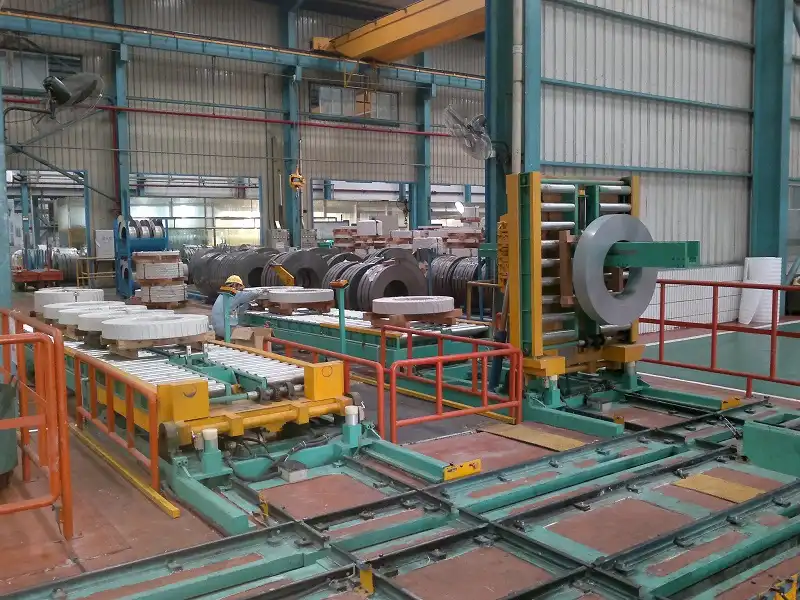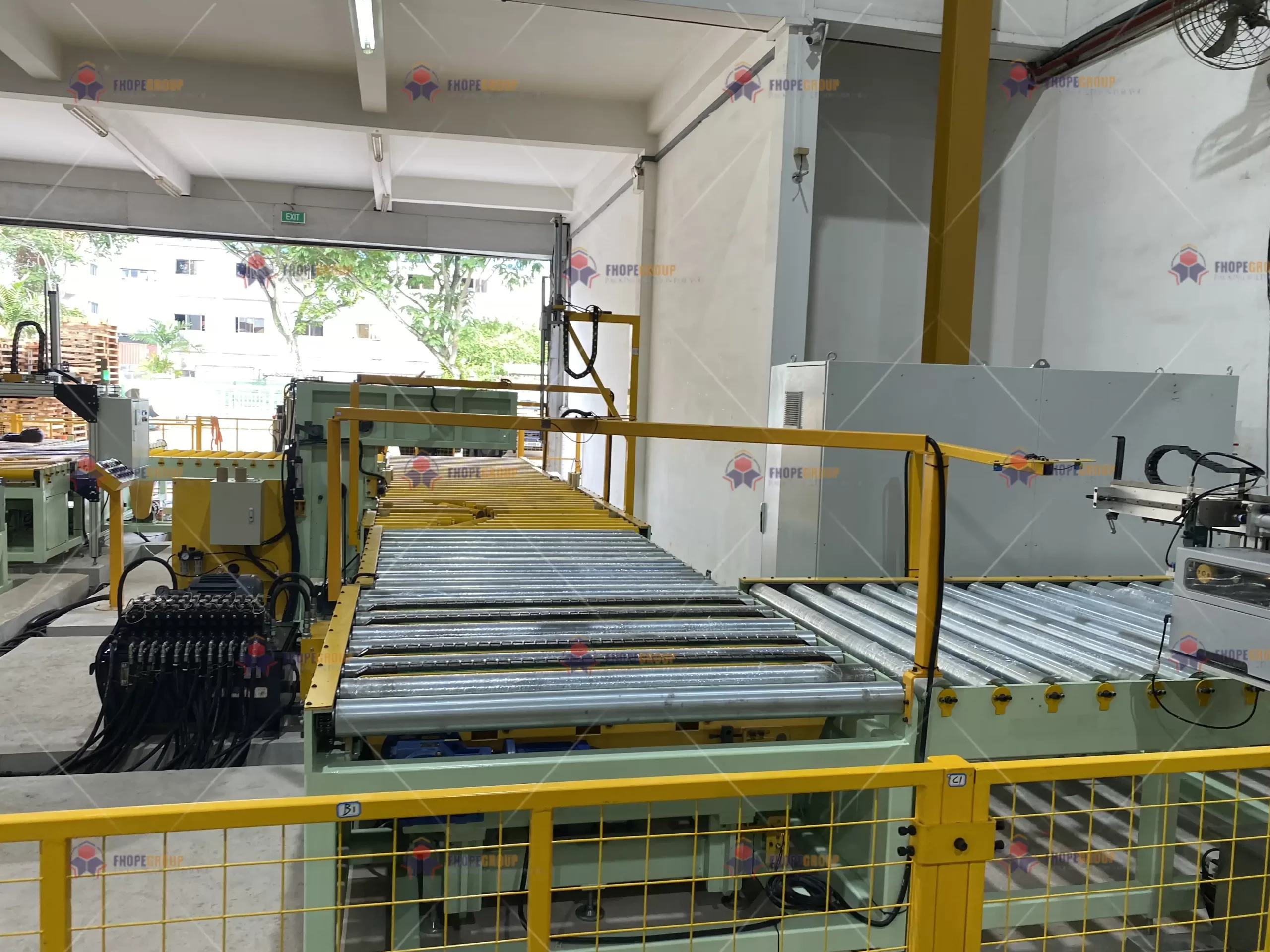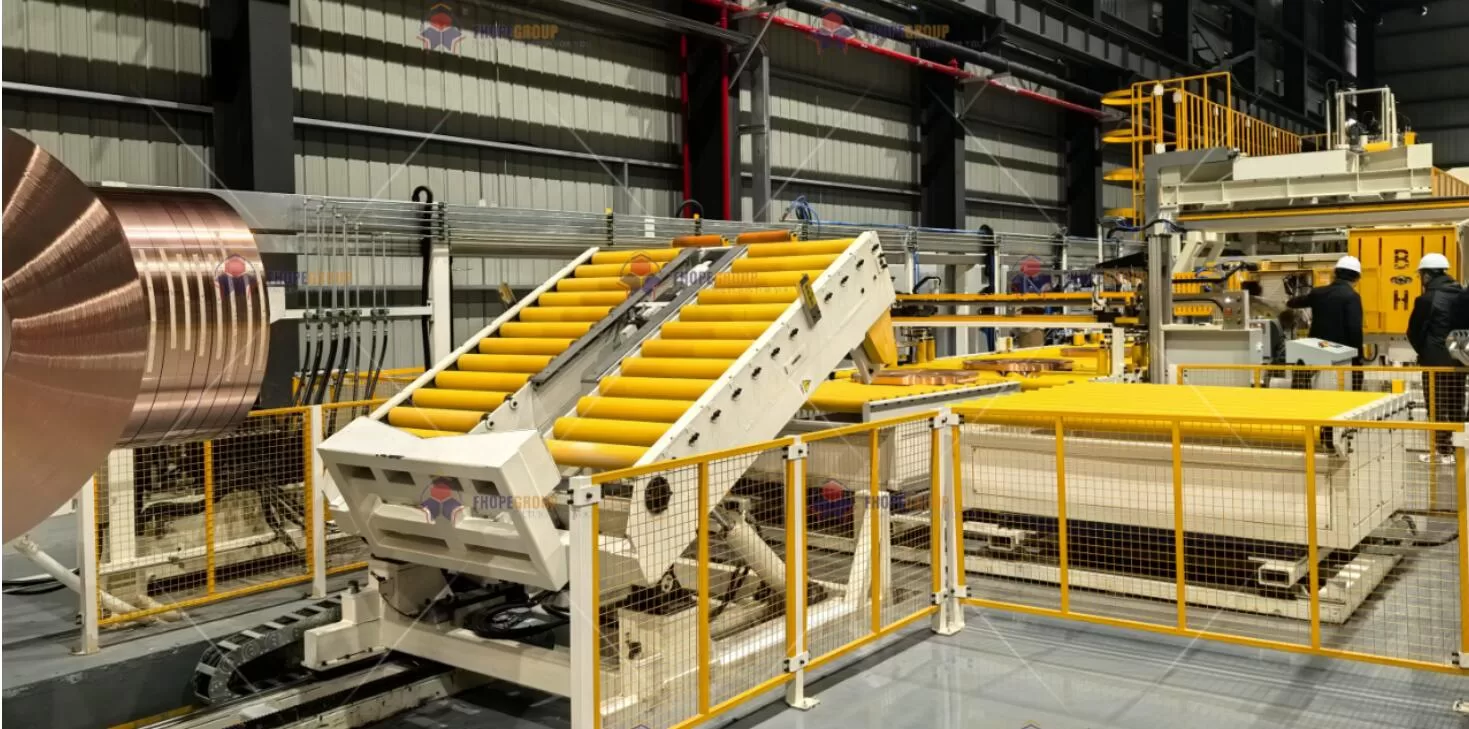You've invested millions in producing high-quality steel, aluminum, or copper coils. But your final packaging step remains a point of constant worry. An old, unpredictable wrapping machine causes frequent downtime, damages your valuable products, and creates serious safety risks on the factory floor. Each damaged coil is a direct blow to your bottom line. Every minute of downtime from a faulty wrapper disrupts your entire production schedule, making it impossible to achieve your operational efficiency goals. You find yourself constantly concerned about meeting strict safety standards and the endlessly rising costs of maintaining outdated equipment. Imagine a packaging solution that is not just a machine, but a guarantee. A system built with precision engineering, backed by rigorous CE certification, that protects your product, your people, and your profits. This is the standard of reliability and performance I've come to associate with top-tier, Italian-style engineering.
To protect your coils the "Italian way," you need a wrapping solution that combines robust mechanical design with advanced safety features, all verified by CE certification. This approach ensures maximum reliability, minimizes product damage during handling and transport, and guarantees compliance with international safety standards, providing a total solution for your packaging needs.

I’ve spent my entire career in the packing machine industry, from my first days as an engineer on the factory floor to founding my own company, SHJLPACK. I’ve seen firsthand how the right piece of equipment can transform an entire operation. But I also know that terms like "Italian quality" can sound like marketing fluff. What does it really mean for a steel mill owner like you, who faces daily pressures of cost, safety, and uptime? And how does a CE sticker on a machine actually impact your daily operations and your long-term strategic goals? Let's break it down, engineer to engineer.
What Makes Italian-Engineered Coil Wrapping Machines So Reliable?
Are you tired of wrapping machines that constantly fail? Do you need a system you can count on, day in and day out, to keep your production line moving without interruption? I know that downtime isn't just an inconvenience for you; it's a major cost driver that directly impacts your profitability and your ability to meet market demands. An unreliable machine forces your maintenance team to fight fires instead of performing the preventative work that truly saves money. It creates bottlenecks that ripple through your entire plant, from the slitter to the shipping bay. This instability makes it impossible to plan effectively or achieve the kind of operational excellence you're striving for. The solution lies in a different philosophy of machine design. Italian engineering is renowned for its focus on durability, high-quality components, and precision mechanics. These machines are not built to be the cheapest option; they are built to last and perform under the heavy-duty, 24/7 demands of a modern steel mill.
Italian-engineered coil wrapping machines are reliable because they prioritize robust construction, use high-quality, brand-name components for critical parts like motors and sensors, and feature simple, effective mechanical designs over overly complex systems. This focus on durability and performance, honed over decades in demanding industrial environments, results in higher uptime and a longer operational life.

Diving Deeper into Durability and Design
When I talk about reliability, it's not an abstract concept. It comes down to specific, tangible choices made during the design and manufacturing process. I remember visiting a client's plant in Mexico years ago. They had a locally-made wrapper that was a constant headache for their general manager, a man much like you, Javier, who was sharp and focused on numbers. We looked at the design together. The frame was built from thin steel that would flex under the weight of heavy coils, causing misalignment and frequent film tears. The motors were generic and would constantly overheat, tripping the breakers.
When we replaced it with a machine built on these core Italian engineering principles, their maintenance calls for the wrapping station dropped by over 90% in the first year. It wasn't magic; it was simply good engineering. Let’s look at the core components.
Robust Frame and Mechanics
The foundation of any great machine is its frame. A heavy-duty steel frame, properly welded and reinforced, resists the immense stress and vibration that come from handling multi-ton coils. This structural integrity ensures that all moving parts—the rollers, the wrapping ring, the conveyors—stay in perfect alignment. This eliminates a primary cause of breakdowns and ensures a consistent, high-quality wrap every single time. It's the difference between a machine built for an industrial environment and one that merely looks the part.
Premium Component Selection
A machine is only as strong as its weakest link. This is where a commitment to quality components becomes critical. Instead of using generic or unbranded parts to save a few dollars, reliable machines use world-class components from manufacturers like Siemens, Schneider, and SEW-Eurodrive. These parts are themselves designed for high performance and longevity. Using a premium PLC, reliable sensors, and a durable motor/gearbox combination means fewer electrical faults, less downtime for component replacement, and a system that you can trust to communicate effectively with your other plant systems.
| Feature | Standard Machine | Italian-Engineered Machine |
|---|---|---|
| Frame Construction | Lighter gauge steel, bolted joints | Heavy-duty, welded steel frame |
| Key Motor/Gearbox | Generic or lesser-known brands | SEW, Siemens, or equivalent |
| PLC & Electronics | Basic, proprietary controllers | Siemens, Allen-Bradley, Schneider |
| Sensors & Switches | Standard-grade, less durable | Omron, Sick, or premium brands |
| Design Philosophy | Lowest initial cost | Lowest total cost of ownership (TCO) |
| Expected Lifespan | 5-8 years | 15-20+ years |
This table clearly shows the difference. The initial investment might be higher, but the return in terms of uptime, reduced maintenance, and operational lifespan is enormous. This is the kind of practical analysis that turns an expense into a strategic investment.
How Does CE Certification Translate to Real-World Savings and Safety?
You see "CE Certified" on equipment specifications, but it can feel like just another sticker, another piece of jargon. As a business owner, you need to know if it actually delivers tangible benefits, especially when you are under immense pressure to reduce operational costs and meet increasingly strict governmental safety regulations. An accident on the production line is the ultimate nightmare scenario. It can lead to severe injuries, production shutdowns, regulatory investigations, and huge financial liabilities. You simply cannot afford to take risks with equipment that has not been rigorously vetted for safety and performance. This is where CE certification moves from being a simple label to becoming a powerful tool. It's a comprehensive process that verifies a machine meets the European Union's high standards for safety, health, and environmental protection. For a strategic owner, this certification is a concrete way to de-risk your investment and ensure long-term operational stability.
CE certification translates to real-world savings by ensuring the wrapping machine has integrated safety features like light curtains and emergency stops, which reduces accident risks and potential liability costs. It also guarantees electrical efficiency and system integrity, leading to lower energy consumption and fewer breakdowns, directly supporting your goals of reducing operational costs by 8% or more.

Diving Deeper into the Value of CE
The CE mark is not self-declared for high-risk machinery like industrial wrappers. It requires a detailed technical file, risk assessments, and adherence to specific EU directives. This process forces a manufacturer to build a better, safer, and more efficient machine from the ground up. It directly addresses the core challenges you face.
Mandatory Safety Features
A CE-certified machine is required by law to have non-negotiable safety features built in. This includes safety fences, light curtains that immediately stop the machine if an operator enters a dangerous area, and strategically placed emergency stop buttons. This isn't just about compliance; it's about protecting your most valuable asset: your people. Fewer accidents mean fewer Lost Time Incidents (LTIs), which directly leads to lower insurance premiums and avoids the massive indirect costs associated with workplace injuries. This is a direct contribution to your goal of lowering overall operating costs.
Electrical and Electromagnetic Compatibility (EMC)
This is a critical point that is often overlooked. The CE process includes strict testing for EMC. This ensures two things. First, the machine's electrical system is efficient and safe, preventing power surges or faults that could cause fires or damage other equipment. This helps with your energy reduction goals. Second, and perhaps more important for your digitalization plans, it guarantees the machine will not emit electromagnetic interference that could disrupt your sensitive control systems, MES platforms, or IoT sensors. A non-certified machine could create "ghost" data or communication failures across your network, crippling your move toward a smart factory.
Documentation and Traceability
As part of the certification, the manufacturer must provide a comprehensive technical manual covering operation, maintenance, and a full parts list. This documentation is not a simple pamphlet; it's a detailed guide that empowers your maintenance team. It allows for predictive maintenance and quick troubleshooting, directly supporting your goal of increasing equipment uptime to 95%.
| CE Requirement | Direct Benefit | Impact on Your Goals |
|---|---|---|
| Machinery Directive (2006/42/EC) | Integrated safety guards, light curtains, E-stops. | Reduces accident risk, lowers insurance costs. Contributes to 8% OpEx reduction. |
| Low Voltage Directive (2014/35/EU) | Safe, efficient electrical design. | Prevents electrical faults, reduces energy use. Supports 10% energy reduction goal. |
| EMC Directive (2014/30/EU) | No interference with other plant electronics. | Ensures stability for MES/IoT deployment. Critical for Digitalization & 95% uptime. |
| Risk Assessment & Technical File | Proactive hazard identification and mitigation. | Improves overall plant safety and simplifies maintenance planning. |
Looking at this, you can see that CE certification is not an expense. It is a built-in insurance policy that aligns perfectly with the goals of a forward-thinking factory owner.
Can a Modern Wrapping Solution Truly Integrate with My Aging Production Line?
Your factory runs on equipment that has served you well for over 15 years. You know you need to upgrade your packaging capabilities, but you are rightly concerned that a new, modern machine won't be able to "talk" to your existing infrastructure. The thought of a failed integration project, with its massive costs and operational disruptions, is enough to stop any investment in its tracks. You worry about a nightmare scenario of endless compatibility issues, custom programming headaches, and mechanical misalignments. You fear that a new machine will become an isolated island of technology, unable to connect to your planned MES or IoT platforms, completely defeating your digitalization strategy. The solution is to shift your mindset from buying a product to choosing a partner. A true solutions provider understands that a new machine must become a seamless part of your existing workflow. Modern wrapping solutions, when provided by the right partner, are designed with this integration challenge in mind, using standard communication protocols and flexible mechanical designs to connect with both old and new equipment.
Yes, a modern wrapping solution can integrate with an aging production line by using flexible and open communication protocols like Profinet or Ethernet/IP, allowing it to connect to your existing PLCs and future MES systems. A strategic partner will conduct a thorough site audit to ensure the machine's physical footprint, conveyor heights, and cycle times are perfectly matched to your current workflow.

Diving Deeper into Seamless Integration
Early in my career, I saw many factories buy "off-the-shelf" machines that never quite fit. It was a constant struggle for their engineers. That's why when I founded SHJLPACK, my mission was to provide a total solution. We don't just ship a machine in a box. We become an extension of your engineering team. We come to your plant. We measure everything. We talk to your operators and your maintenance crew. We design the integration plan with you, ensuring the new machine works perfectly from day one. This process breaks down into two key areas: digital and physical.
Bridging the Digital Gap: Communication Protocols
Your older equipment likely runs on older PLCs with different communication standards. A modern machine must be able to bridge this gap. We achieve this by using flexible and universally accepted communication protocols. Whether your plant uses Profibus, Profinet, or Ethernet/IP, we ensure our machine's PLC can speak the same language. This "handshake" is critical. It allows the new wrapper to receive signals from your upstream equipment (e.g., "coil is coming") and send signals to downstream equipment (e.g., "wrapped coil is ready"). This is the foundation for your MES and IoT goals, allowing you to collect vital production data—cycle times, material usage, fault codes—from the new machine and feed it into your central analytics platform.
Solving the Physical Puzzle: Customization
No two factory layouts are identical. A standard machine will almost never fit perfectly. This is where a partnership approach is essential. Our process always starts with a detailed site survey. We measure conveyor heights to the millimeter, analyze the available floor space, and study the flow of your coils. We then customize the machine's infeed and outfeed conveyors, its height, and its orientation to match your existing line perfectly. This avoids costly and time-consuming modifications on-site. It ensures a smooth, continuous flow of product without creating new bottlenecks.
| Integration Aspect | Key Question to Ask | Our Solution Approach |
|---|---|---|
| Mechanical Interface | Will the new machine's conveyors match the height and speed of my existing line? | On-site measurement and custom fabrication of infeed/outfeed conveyors. |
| Control System | Can the new machine's PLC communicate with my older Allen-Bradley/Siemens PLCs? | Use of open communication protocols (Profinet, Ethernet/IP) and joint programming. |
| Data Exchange | How will I get production data from this machine for my new MES system? | Configure the PLC to output key data points (cycles, faults, etc.) in a standard format. |
| Safety System | How does the new machine's E-stop circuit connect to my overall line safety system? | Hardwire the safety circuits to create a unified emergency stop system for the entire line. |
This systematic approach removes the risks of integration and turns the installation of a new machine from a potential problem into a smooth, planned upgrade.
My Insights
I want to share a story with you. A few years ago, I met a client in a situation very similar to yours, Javier. He owned a very successful, family-run steel service center. But his equipment was old, his costs were rising, and his competition was getting tougher. He was brilliant but cautious. He scrutinized every detail of our proposal for a new slitting coil packing line. He wasn't just buying a machine; he was betting on his company's future.
I knew that just sending him a quote and a brochure would not be enough. So, I flew to meet him. I didn't just walk through his plant for an hour. I spent three days there with him and his engineering team. We didn't just talk about my machine. We talked about his entire process, from the moment a master coil arrived to the second a finished pallet was loaded onto a truck. We found bottlenecks he hadn't even considered. We mapped out a new workflow that would save seconds at every step.
The new wrapping machine was a key part of that plan, but it was only one part. By the end, we had designed a complete solution together. He made the investment. A year later, he called me. He told me that his output had increased by 30%, and his packaging costs had dropped by 15%. But that wasn't what made me proud. He said, "Vincent, you didn't just sell me a machine. You helped me build a better business."
His success became my success. That experience solidified my belief that this business isn't about single transactions. It's about building partnerships. I started as an engineer on the factory floor, and this industry has given me everything. Helping a fellow entrepreneur like him succeed—that is how I give back. That is the grateful spirit and commitment I bring to every single project.

Conclusion
Choosing the right wrapping solution is a strategic investment in your plant's reliability, safety, and future growth. Let us be your partner in building that future.





